For the 2025 school year, there are 2 public preschools serving 628 students in Sumter County School District. This district's average pre testing ranking is 1/10, which is in the bottom 50% of public pre schools in Alabama.
Public Preschools in Sumter County School District have an average math proficiency score of 3% (versus the Alabama public pre school average of 31%), and reading proficiency score of 19% (versus the 49% statewide average).
Minority enrollment is 100% of the student body (majority Black), which is more than the Alabama public preschool average of 48% (majority Black).
Overview
This School District
This State (AL)
# Schools
4 Schools
648 Schools
# Students
911 Students
310,670 Students
# Teachers
52 Teachers
18,546 Teachers
Student : Teacher Ratio
18:1
18:1
District Rank
Sumter County School District, which is ranked within the bottom 50% of all 145 school districts in Alabama (based off of combined math and reading proficiency testing data) for the 2021-2022 school year.
The school district's graduation rate of 70-74% has decreased from 75-79% over five school years.
Overall District Rank
#142 out of 145 school districts
(Bottom 50%)
(Bottom 50%)
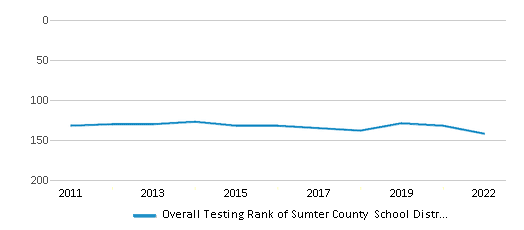
Math Test Scores (% Proficient)
2%
29%

Reading/Language Arts Test Scores (% Proficient)
20%
47%
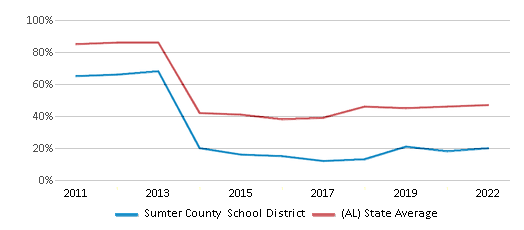
Science Test Scores (% Proficient)
≤5%
38%

Graduation Rate
70-74%
88%
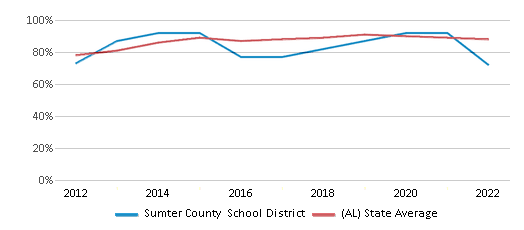
Students by Ethnicity:
Diversity Score
0.03
0.63
# American Indian Students
n/a
3,275 Students
% American Indian Students
n/a
1%
# Asian Students
4 Students
3,474 Students
% Asian Students
n/a
1%
# Hispanic Students
1 Student
33,026 Students
% Hispanic Students
n/a
11%
# Black Students
896 Students
93,822 Students
% Black Students
98%
30%
# White Students
5 Students
162,634 Students
% White Students
1%
52%
# Hawaiian Students
n/a
315 Students
% Hawaiian Students
n/a
n/a
# Two or more races Students
5 Students
14,124 Students
% of Two or more races Students
1%
5%
Students by Grade:
# Students in PK Grade:
35
21,304
# Students in K Grade:
66
49,720
# Students in 1st Grade:
53
50,373
# Students in 2nd Grade:
78
48,594
# Students in 3rd Grade:
73
40,410
# Students in 4th Grade:
55
36,751
# Students in 5th Grade:
58
31,378
# Students in 6th Grade:
68
12,553
# Students in 7th Grade:
59
4,421
# Students in 8th Grade:
83
4,401
# Students in 9th Grade:
72
2,950
# Students in 10th Grade:
75
2,768
# Students in 11th Grade:
70
2,555
# Students in 12th Grade:
66
2,492
# Ungraded Students:
-
-
District Revenue and Spending
The revenue/student of $19,428 is higher than the state median of $13,006. The school district revenue/student has grown by 31% over four school years.
The school district's spending/student of $18,514 is higher than the state median of $12,220. The school district spending/student has grown by 31% over four school years.
Total Revenue
$18 MM
$9,671 MM
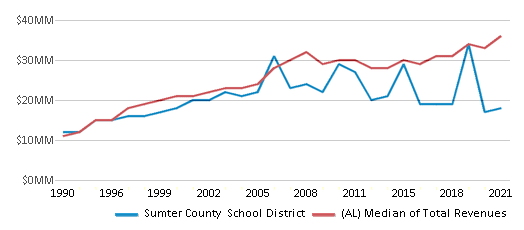
Spending
$17 MM
$9,086 MM
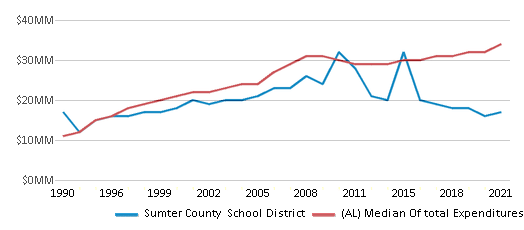
Revenue / Student
$19,428
$13,006
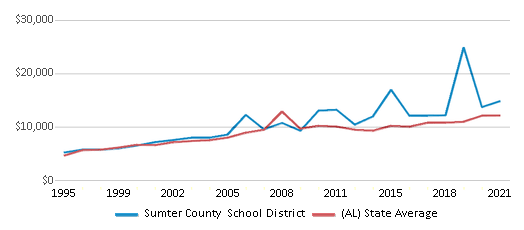
Spending / Student
$18,514
$12,220
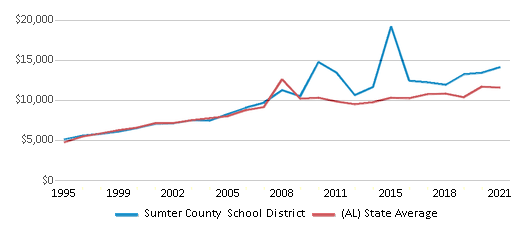
Best Sumter County School District Public Preschools (2025)
School
(Math and Reading Proficiency)
(Math and Reading Proficiency)
Location
Grades
Students
Rank: #11.
York West End Junior High School
(Math: ≤5% | Reading: 20-24%)
Rank:
Rank:
2/
Bottom 50%10
716 Country Club Road
Livingston, AL 35470
(205) 379-4950
Livingston, AL 35470
(205) 379-4950
Grades: PK-8
| 241 students
Rank: #22.
Livingston Junior High School
(Math: 2% | Reading: 18%)
Rank:
Rank:
1/
Bottom 50%10
1351 North Washington Street
Livingston, AL 35470
(205) 652-2125
Livingston, AL 35470
(205) 652-2125
Grades: PK-8
| 387 students
Recent Articles

Year-Round Or Traditional Schedule?
Which is more appropriate for your child? A year-round attendance schedule or traditional schedule? We look at the pros and cons.

Why You Should Encourage Your Child to Join a Sports Team
Participating in team sports has a great many benefits for children, there is no doubt. In this article you will learn what those benefits are.

White Students are Now the Minority in U.S. Public Schools
Increasing birth rates among immigrant families from Asia and Central and South America, combined with lower birth rates among white families, means that for the first time in history, public school students in the United States are majority-minority. This shift in demographics poses difficulties for schools as they work to accommodate children of varying language abilities and socio-economic backgrounds.





